If your furry best friend has been struggling with an upset stomach, vomiting, or diarrhea, you’re not alone. Many dog parents have faced the same worry: how do you soothe your dog’s tummy without compromising nutrition? The answer often starts with a bland dog food recipe chicken-based, a simple, gentle, and nourishing way to help your dog recover naturally.
In this post, we’ll explore why boiled chicken is the go-to ingredient for bland diets, how to prepare it safely, what to mix it with, and when to serve it. You’ll also find three tested recipes and expert tips for healing your dog with homemade meals. Whether your pup is recovering from GI distress or just needs a reset meal, this guide will walk you through every step with care.
Table of Contents
Why Chicken is Ideal in bland dog food recipe chicken
Benefits of Chicken in a Dog’s Bland Diet
When your dog isn’t feeling well, boiled chicken becomes the best friend you didn’t know you needed. Chicken is a lean, easily digestible protein that’s gentle on sensitive stomachs. It delivers essential amino acids that support muscle repair, immune strength, and energy without overwhelming the gut.
Here’s why chicken is often the top pick for a bland diet:
- Low in fat, especially when skinless
- Packed with protein to maintain strength during recovery
- Mild flavor that dogs love, even when they’re under the weather
- Easy to digest when prepared correctly
- Affordable and accessible in almost every kitchen
At Home Dog Recipes, we always recommend sourcing organic or antibiotic-free chicken when possible, especially when your pup is healing. The cleaner the ingredients, the faster the recovery.
Nutritional Value of Boiled Chicken
Chicken doesn’t just help calm the tummy — it’s a nutritional powerhouse in the bland diet world. Let’s break it down per 3 oz serving (boiled, skinless, boneless):
| Nutrient | Amount |
|---|---|
| Protein | 26g |
| Fat | 2.7g |
| Calories | 142 |
| Selenium | 24 mcg |
| Niacin | 10 mg |
| Vitamin B6 | 0.5 mg |
It’s especially rich in niacin and vitamin B6, both crucial for converting food into energy and supporting immune health. Combined with soothing carbs like white rice or pumpkin, chicken provides a complete base for a bland, healing meal.
How to Prepare bland dog food recipe chicken
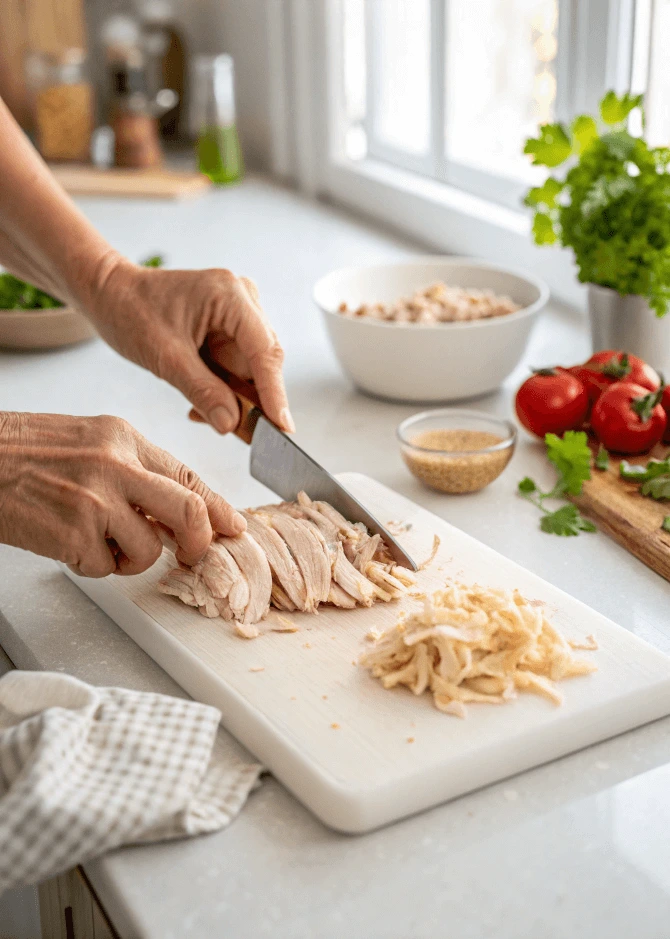
Step-by-Step: bland dog food recipe chicken
Preparing bland chicken for your dog isn’t complicated—but it must be done right to ensure safety and effectiveness. Follow this simple, vet-approved recipe to make a stomach-soothing meal for your pup.
Ingredients:
- 1 skinless, boneless chicken breast or thigh
- 2 cups of filtered water
Optional: ½ cup white rice or plain pumpkin (only if your vet recommends it)
nstructions:
- Rinse the chicken under cold water to remove surface residue.
- Place chicken in a pot with enough filtered water to submerge it completely.
- Boil gently over medium heat for 15–20 minutes or until fully cooked (internal temp: 165°F).
- Cool completely before shredding the chicken into bite-sized pieces.
- Serve plain or mix with rice (1:2 chicken-to-rice ratio).
Pro Tip: Avoid adding salt, oils, garlic, onions, or seasonings. These can be toxic to dogs, especially when their stomach is sensitive.
Cooking Tips: How to Boil Chicken the Right Way
There’s more to boiling chicken than just tossing it in a pot. Here are expert cooking tips to get the most from your bland dog food recipe chicken:
- Use filtered or spring water to avoid chemicals like chlorine.
- Skim off foam during boiling—it helps remove impurities.
- Check doneness with a meat thermometer (165°F inside).
- Let it cool fully before feeding—it protects your dog’s mouth and aids digestion.
- Shred or finely chop to make swallowing easier, especially for older or small-breed dogs.
Some dog owners prefer to batch cook chicken and freeze individual portions for emergencies. Just make sure it’s tightly sealed and reheated safely before serving.
Don’t miss our guide on Best Vegetables for Dogs with Sensitive Stomachs — perfect pairings for your bland chicken mix.
Best Ingredients to Pair with bland dog food recipe chicken
Safe Carbs: White Rice, Pumpkin & Potatoes
When your dog is on a bland diet, pairing chicken with the right carbohydrate helps deliver balanced energy without irritating their stomach. The best carbs are low-fiber, gentle, and easy to digest.
Here are the safest options to mix with your boiled chicken:
1. White Rice
A staple in most bland diets. White rice is plain, non-irritating, and helps firm up loose stools. Use long-grain or jasmine rice, and always cook it plain—no butter or salt.
Mix ratio: 2 parts cooked white rice to 1 part shredded chicken.
2. Plain Pumpkin (Canned or Fresh)
Pumpkin contains soluble fiber that supports healthy digestion. Just make sure it’s 100% plain pumpkin, not pumpkin pie filling.
Serving tip: Add 1 tablespoon to a small meal or 2 tablespoons for medium/large dogs.
3. Boiled White Potatoes or Sweet Potatoes
Both are low-fat, gentle on the gut, and rich in potassium. Peel and boil until soft—no skins, spices, or dairy.
Great for dogs recovering from vomiting, as it helps restore energy without upsetting the stomach.
These carb sources can be rotated or combined with the chicken to create simple, soothing meals your dog will enjoy—even when they’re not feeling their best.
What You Should NEVER Add
It’s tempting to “flavor up” a bland meal, but when your dog is recovering, simplicity is key. Here’s what to avoid completely:
| Unsafe Additives | Why to Avoid |
|---|---|
| Onions/Garlic | Highly toxic to dogs, even in small amounts |
| Salt & Seasonings | Can irritate the gut and lead to dehydration |
| Oils/Butter | Fatty ingredients worsen diarrhea or vomiting |
| Dairy (milk, cheese) | Many dogs are lactose-intolerant |
| Bones | Can splinter and cause internal damage |
Even well-meaning additions can delay healing. When in doubt, keep it plain and consult your vet.
Top 3 Bland Chicken Recipes for Dogs
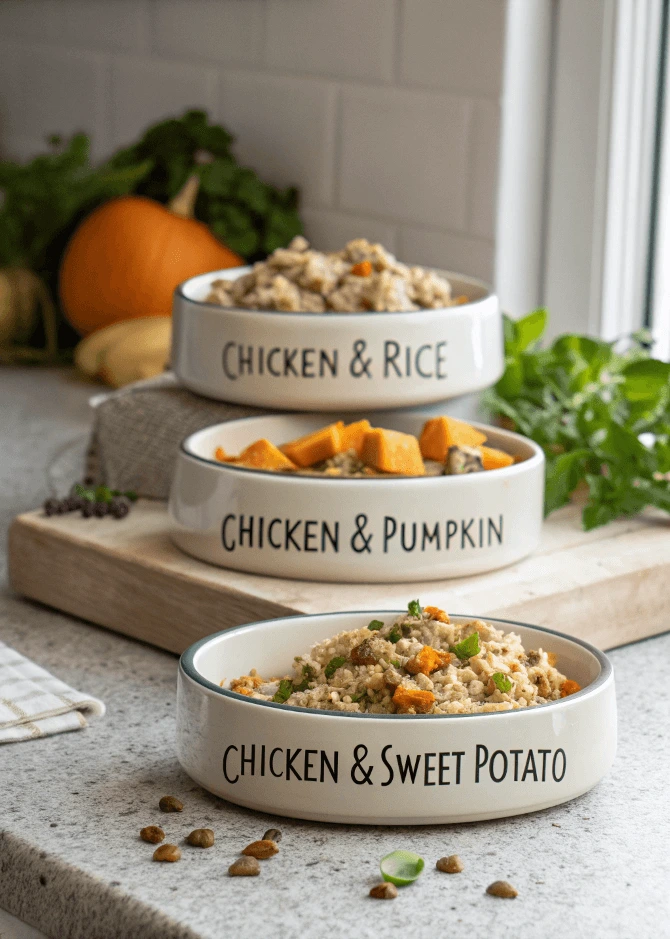
When your pup’s stomach is upset, offering a meal that’s simple, balanced, and nourishing makes all the difference. Here are three safe and vet-friendly chicken-based bland dog food recipes that provide gentle nutrition while supporting your dog’s recovery.
1. Classic Chicken & White Rice
This is the most commonly recommended recipe by vets for dogs with diarrhea or vomiting. It’s easy to digest and provides energy without overloading the gut.
Ingredients:
- 1 skinless, boneless chicken breast
- 1 cup white rice
- 2 cups filtered water
Instructions:
- Boil chicken until fully cooked. Shred finely.
- Cook rice separately in plain water (no salt, oils, or spices).
- Mix chicken and rice in a 1:2 ratio (chicken:rice).
- Let cool and serve in small portions.
Feeding Tip: Start with smaller meals—about ¼ cup for small dogs, ½ to 1 cup for medium to large breeds.
2. Chicken & Pumpkin Digestive Mix
Ideal for dogs with loose stools or constipation, this recipe combines lean protein with pumpkin’s natural digestive fiber.
Ingredients:
- 1 cup shredded boiled chicken
- ½ cup plain canned pumpkin (no sugar or spices)
- Optional: 1 tbsp bone broth (unsalted, dog-safe)
Instructions:
- Combine ingredients once cooled.
- Stir until evenly mixed.
- Serve slightly warmed or at room temperature.
Nutritional Perk: Pumpkin supports gut motility, while chicken supplies protein and comfort.
3. Chicken with Sweet Potato Mash
This soothing option is great for picky eaters or pups with sensitive taste buds. Sweet potato is full of vitamins like A and C and offers anti-inflammatory benefits.
Ingredients:
- 1 cup boiled chicken
- ½ cup boiled, mashed sweet potato (peeled)
- 1 tsp finely chopped fresh parsley (optional and vet-approved)
Instructions:
- Boil sweet potato until soft. Mash with a fork.
- Shred chicken and combine with mash.
- Add a pinch of fresh parsley for natural breath freshening.
Note: Always cool food before serving and store leftovers in the fridge (up to 3 days max).
Can I Add Flavor to bland dog food recipe chicken?
When your dog’s appetite is low, even boiled chicken can seem… well, boring. As dog parents, it’s natural to wonder if you can safely enhance the flavor of a bland diet without upsetting your pup’s stomach. The good news? You can—but with caution.
Vet-Approved Flavor Enhancers
Here are a few gentle and dog-safe ways to boost flavor without compromising your dog’s bland food plan:
1. Plain Bone Broth (Low-Sodium)
Bone broth is soothing, hydrating, and packed with minerals that support healing. Just make sure it’s:
- Homemade or store-bought with no onions, garlic, or salt
- Cooled before serving
- Added in small amounts to moisten dry chicken
Use 1–2 tablespoons of broth per meal to enhance palatability.
2. Plain Canned Pumpkin (No Spices)
Pumpkin adds both taste and texture. Dogs often enjoy the slightly sweet, earthy flavor, and it helps regulate digestion.
3. Fresh Herbs (Parsley or Basil)
In tiny, chopped amounts, fresh herbs can make a dish more aromatic. Parsley also helps with bad breath, and basil offers mild anti-inflammatory properties.
4. Cooked Quinoa or Oatmeal (in moderation)
Both are gentle, grain-based options that absorb flavors well. Be sure they’re plain, fully cooked, and introduced slowly.
Looking for inspiration? Try our Bone Broth Recipe for Dogs – a safe and nutritious way to boost flavor.
Avoiding Harmful Additives
It’s crucial to remember that dogs on a bland diet are usually recovering. Their digestive systems are sensitive, so avoiding harmful or rich additives is a must.
Never use:
- Salt or seasoning blends
- Garlic, onion, leeks, or chives
- Soy sauce or bouillon cubes
- Butter, oil, or fat trimmings
- Gravy or table scraps
Even “natural” flavorings meant for humans can lead to setbacks like vomiting or diarrhea in dogs.
When in doubt? Keep it simple. The goal of a bland diet is healing, not gourmet dining.
Nutritional Add-Ins to Support Healing
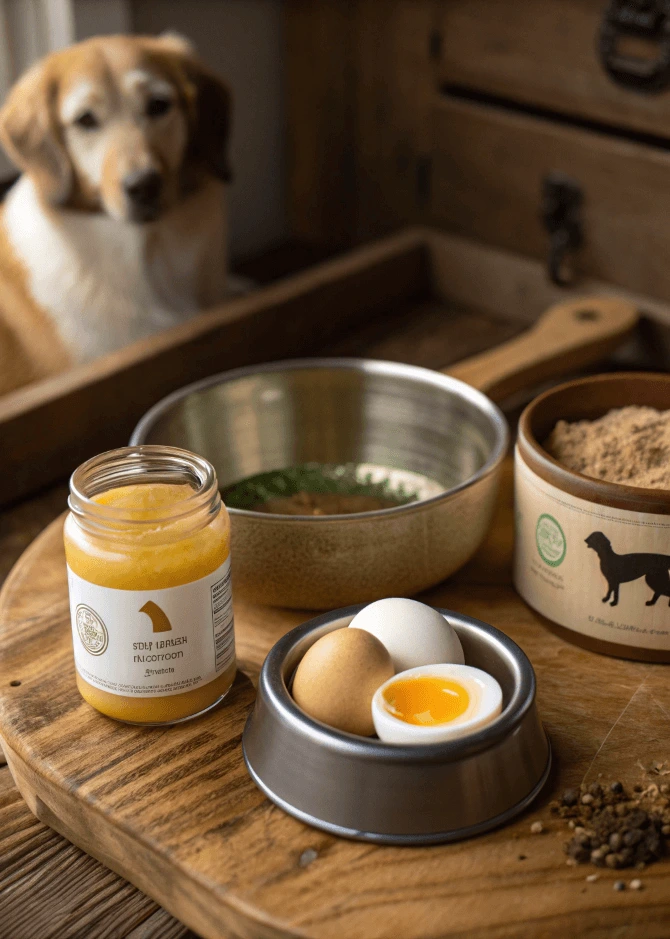
While the bland diet is designed to be simple, there are a few safe and nutritious add-ins that can enhance recovery and support your dog’s overall health. These ingredients can be slowly introduced once symptoms begin to improve—always with your vet’s guidance.
Are Eggs Safe in a Bland Diet?
Yes, eggs are generally safe for dogs on a bland diet—if prepared properly. They’re an excellent source of easily digestible protein, healthy fats, and vitamins like B12 and riboflavin.
How to Use Eggs:
- Boil or scramble plain eggs with no butter, oil, or seasoning.
- Introduce in small amounts: about 1 tablespoon for small dogs, 2 tablespoons for larger breeds.
- Eggs can be mixed with shredded chicken and rice for added protein and flavor.
Note: Avoid raw eggs during digestive distress—they may worsen symptoms or carry bacteria.
Using Probiotics, Bone Broth, or Dog-Friendly Herbs
To gently boost gut health and immune support, you can incorporate the following natural, dog-safe nutritional add-ons into your bland dog food recipe chicken mix:
1. Probiotics
- Probiotics help restore healthy gut flora during and after illness.
- Choose a vet-recommended dog-specific supplement or plain, unsweetened yogurt in small amounts (if your dog tolerates dairy).
2. Bone Broth
- As mentioned earlier, bone broth is rich in collagen, glucosamine, and minerals that support joint health and digestion.
- Add a few spoonfuls to dry chicken and rice to entice picky eaters.
3. Dog-Safe Herbs
- Parsley, turmeric, and ginger (in minimal amounts) can offer anti-inflammatory and soothing properties.
- Use dried or fresh, but always in micro-doses: a pinch or less per meal.
Always introduce one new element at a time and monitor your dog for any changes in stool, energy, or appetite.
When to Feed Bland Chicken and For How Long
Feeding your dog a bland chicken-based diet is a short-term strategy designed to soothe digestion and restore appetite. But how long should you feed it—and how do you know when it’s time to stop?
Feeding Guidelines by Dog Size and Condition
Here’s a simple guide to how much bland food to offer per meal, depending on your dog’s size and how they’re feeling:
| Dog Size | Portion Per Meal | Frequency |
|---|---|---|
| Small (5–15 lbs) | ¼ to ½ cup | 3–4x/day |
| Medium (16–40 lbs) | ½ to 1 cup | 2–3x/day |
| Large (41–80 lbs) | 1 to 1½ cups | 2x/day |
| X-Large (81+ lbs) | 1½ to 2 cups | 2x/day |
Always divide the daily portion into smaller meals to avoid overwhelming your dog’s stomach.
If your dog is recovering from vomiting or diarrhea, start with smaller amounts (1–2 tablespoons every few hours) on the first day. Gradually increase the quantity as they keep the food down.
Water is essential: Keep your pup hydrated with small sips of fresh water. Consider offering ice chips if they’re refusing to drink.
When to Transition Back to Normal Dog Food
Most dogs stay on a bland diet for 2 to 5 days, depending on the severity of symptoms and your vet’s recommendations. Transitioning too soon can cause a relapse, while waiting too long may create nutritional imbalances.
Signs your dog is ready to transition:
- Normal, firm stools for 24–48 hours
- No vomiting or nausea
- Return of normal appetite and energy
How to Transition:
- Day 1: 75% bland diet, 25% regular food
- Day 2: 50/50 blend
- Day 3: 25% bland, 75% regular food
- Day 4: Back to 100% regular food
Transition slowly to avoid re-triggering GI symptoms.
FAQs About Bland Dog Food Recipe Chicken
How do I make bland chicken for my dog?
Boil skinless, boneless chicken in plain water until fully cooked. Shred it and serve plain or mixed with rice or pumpkin.
Is chicken a bland diet for dogs?
Yes, plain boiled chicken is one of the most common ingredients in a vet-recommended bland diet for dogs with digestive issues.
What is the best bland diet recipe for dogs?
The classic chicken and rice mix is the best. Use a 1:2 ratio of shredded chicken to white rice. Add pumpkin for extra digestive support.
What can I mix with chicken for my dog?
You can safely mix in plain white rice, canned pumpkin, boiled sweet potatoes, or a small amount of low-sodium bone broth.
Are eggs OK for bland diet for dogs?
Yes, plain boiled or scrambled eggs can be added in moderation. They are easy to digest and full of healthy protein.
How to add flavour to bland dog food recipe chicken?
Add dog-safe flavor boosters like plain bone broth, pumpkin, or a pinch of fresh parsley. Avoid salt, seasonings, garlic, and onion.
Conclusion
A bland dog food recipe chicken isn’t just for upset stomachs—it’s a nutritious, loving way to help your dog heal. By choosing real, simple ingredients and preparing them safely, you’re giving your pup the care they need to bounce back stronger and happier.
With the right blend of chicken, carbs, and compassion, even the most sensitive stomachs can find comfort in a bowl of homemade goodness.
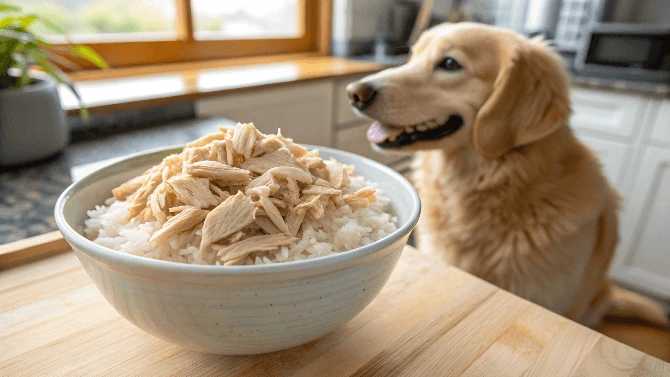
bland dog food recipe chicken
Ingredients
1 boneless, skinless chicken breast
1 cup white rice (uncooked)
2 cups filtered water
Instructions
- Rinse the chicken breast under cold water.
- Place chicken in a pot and cover with filtered water.
- Boil gently for 15–20 minutes or until fully cooked.
- In a separate pot, cook white rice using plain water (no salt or seasonings).
- Let both the chicken and rice cool completely.
- Shred the chicken finely.
- Combine 1 part shredded chicken with 2 parts cooked rice.
- Serve in small portions appropriate to your dog’s size.
Notes
- Do not add any seasoning, salt, oils, garlic, or onions.
- Store leftovers in the fridge for up to 3 days in an airtight container.
- Ideal for short-term feeding during digestive issues.
- Always consult your vet before starting a bland diet.
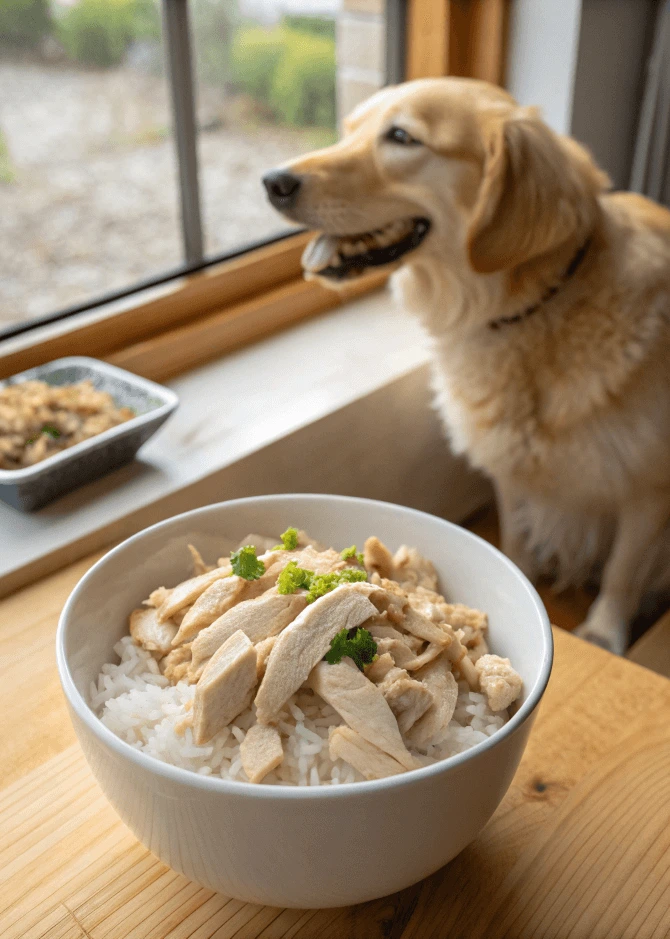
1 thought on “Bland Dog Food Recipe Chicken: The Best 3 Gentle Meals”